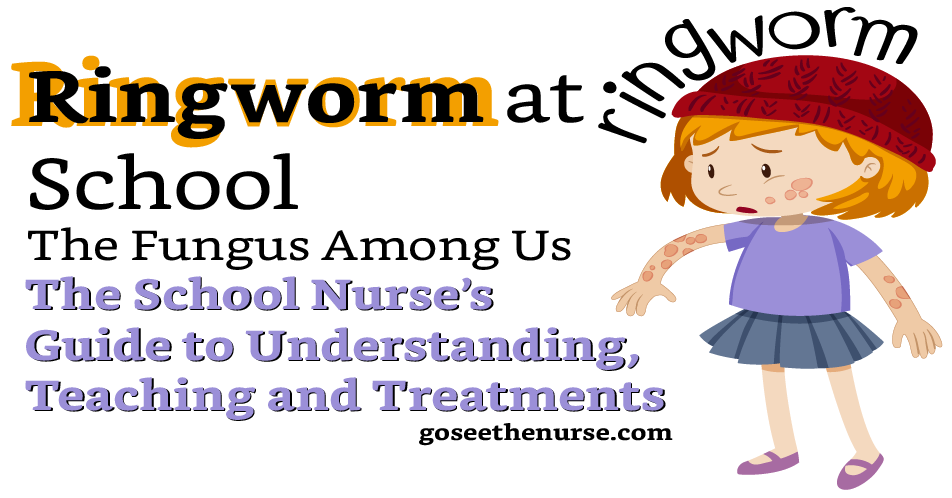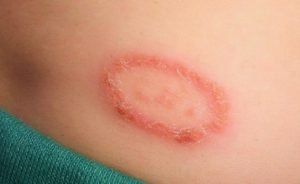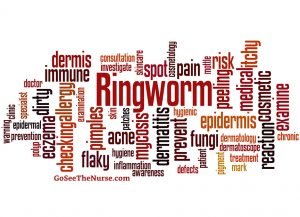
You ever get an itch? Sure you do; we all itch once in a while. The challenge is: Can you get through this article without scratching…nope…you’re already noticing an itchy spot, right?
It’s not a parasite, it’s a fungus! Okay…that video was way out of line…well…maybe not “way out.” Anyway…
Let’s talk a quick bit about ringworm, or tinea, to be more “scientific.” Actually, tinea is a broad term used to describe a type of skin infection. Ringworm is also known as tinea corporis if it’s located on an area without hair and tinea capitis or tinea barbae if it’s found on an area of the scalp or face that has hair. There’s also tinea pedis (the “pedis” is a dead-give-away for “foot” and describer “athlete’s foot”), and tinea cruris (I don’t know where the “cruris” came from; tinea cruris is also known as “jock itch” (uh huh)). There are other forms of tinea:
Ringworm of the face (tinea faciei)
Ringworm of the beard (tinea barbae)
Ringworm of the scalp (tinea capitis)
Ringworm of the hands (tinea manus)
Ringworm of the foot (tinea pedis)
Ringworm of the nails (tinea unguium)
Ringworm of the groin (tinea cruris)

Hold the phone! Remember: I am a school nurse. I am a registered nurse. What I am not is a physician or a dermatologist. I cannot diagnose and am limited on the medical advice I can offer. This information is just that: INFORMATION. Seek the direction of a physician before implementing any of this information. And, please, don’t medicate any child without a physician’s order or parental permission (topical application is not an exception).
Causes of Ringworm
Ringworm is caused by Dermatophytes. Dermatophytes describe three types of fungus that cause skin disease. So, no! There’s actually NO WORM involved. “The ancient Greeks called ringworm ‘herpes,’ meaning ‘ring,’ while the ancient Romans called it ‘tinea,’ referring to the larval stage of a clothes moth. Characterized by round skin lesions (rings) and the early belief that the infection was caused by a parasite (worm), the English word ‘ringworm’ was born sometime in the early 15th century.” . Well, dang! There goes my fishing plans! (oh…never mind…bad joke).
Ask the parents this question: “Do you have a cat?” More than likely, the child has a pet cat or has come into contact with a kitty. Not to dish on cats because contracting ringworm from a dog, goat, or a pet monkey is possible, too. (I always wanted a pet monkey.) Nonetheless, ringworm cases are more often found in children and especially in children who have cats as pets.
You Can Catch Ringworm By:
1. Directly in person-to-person contact.
2. Indirectly by touching an object that has spores from someone else’s active fungal infection.
3. When touching, petting, or grooming an animal with the infection. Cats aren’t the only critters with the cooties.
4. Digging in the soil. As a homesteader (http://www.backtothehomestead.com), this is somewhat troubling to know.
5. I am sure you’ve heard a parent remark, “My kid caught ringworm from school.” Nope, schools don’t manufacture funguses and inoculate unsuspecting children (again…bad joke…sorry).
Identifying Ringworm
I describe the lesions in my documentation as “red, dry, and ‘itchy’ areas that are ringworm-like in nature.” There are so many other ways to describe the lesion, such as a “round, lesion-like area.” The area will start as a red and dry patch and then form a ring pattern. It’s almost like a small circle with a center that appears clear of the infection. But this is not always the case. Some of the infected areas will appear like round/oval, scaly, dry patches. Sometimes the areas appear atypical, as if there is just a rash in the area that is really, really itchy. However, the ring pattern gave ringworm its name; not every person who’s infected develops the rings.

Treatment of Ringworms
The CDC suggests treatment options from topical Lotrimin to oral Diflucan.
Commonly, for areas not covered in hair, a topical antifungal cream is used. If the ringworm is found in the hair, an oral antifungal is used (for tinea unguium as well). Yes, just that simple…most of the time. Parents may not know this and feel they need to rush off to the doctor. Information is powerful!! A word of suggestion (“warning” just seems so harsh): I usually say, “If it were my child, [TREATMENT] is what I would do.” Diagnosing and offering treatment options may not fall within the nursing scope of practice. We as nurses are limited; we as parents have a much larger list of options. You get that, right?
Not all school districts require that children with ringworm be excluded and sent home for the day. As the school nurse, my suggestion is to make sure that the lesions are covered and the child understands how to perform good hand washing. Truth be known, you will likely shake hands with someone this year who has a bad case of tinea cruris and did not wash their hands. Heck, you’ll shake hands with someone this week who has something worse and didn’t wash their hands. After treatment has begun, the risk of spreading the infection is reduced. Most folks have a different paradigm regarding the infection; I’ve had parents remark that children with ringworm should not be allowed in school until they are healed yet are A-OK with a child suffering from jock itch remaining at school. Knowledge is power.
According to Aronson and Shope in the book Managing Infectious Disease in Child Care and Schools, “Once the child begins treatment with a medication taken by mouth, the child is no longer considered infectious.”
Natural Remedies For Ringworm
Aside from all the over-the-counter (OTC) options, there are some cool things you and the parents of your children have lying around the house that will suffice as an antifungal. There are those parents who want only natural options to cure infections and those parents who would like to try natural first before jumping into the OTC options. These options include:
Apple Cider Vinegar
Apple cider vinegar’s pH is between 3 and 5. If you understand the pH scale, that 3 to 5 is pretty huge! Nonetheless, because children’s skin has a more neutral pH (and a pH that ringworm thrives in), increasing the pH in a confined, local area may aid in ridding the skin of the fungal infection. (Note: Adults have what’s called the acid mantle on their skin.)
All you need is apple cider vinegar and a cotton ball (or even a paper towel). Apply the cider-soaked cotton ball to the infected area about 3-5 times a day. Keep doing this until the lesions are gone. It takes a bit of time (but mainly based on the skin’s healing ability…the fungus may be gone, but the alteration to the skin integrity remains…at what point this happens is unknown).
Garlic
Garlic contains allicin and ajoene, which are fungus killers! Kids won’t like the smell, but…it is what it is (let them lick the honey spoon, and they’ll get over it). This method works by creating a paste-like goo that you apply to the infected areas 2-3 times a day and leave on for about an hour (use a cotton ball and a Band-Aid).
Crush 1-3 cloves of garlic and mix them with 2-3 tablespoons of olive oil and 2-3 tablespoons of honey. Smear the goo on a cotton ball like cheese on a cracker and secure to the skin for about an hour.
Turmeric
When we talk about natural remedies, we would never forget to include turmeric. Folks have been using this stuff for centuries with amazing results (only it’s cheap and abundant and has nowhere near the profit potential that Big Pharma is looking for).
All you have to do is make a sticky paste like the garlic example, but only use the olive oil (honey is okay but not completely necessary [unless you are the one licking the spoon]). Apply the sticky paste to the infected area and leave in place for about 15-20 minutes. Do this until the lesions are healed.
There may be a yellow stain on the skin because of the turmeric. It should go away (tongue-in-cheek).
Coconut Oil
Coconut oil (especially organic, expeller-pressed oil) is awesome. There’s no need to do anything other than apply the solid-at-room-temperature stuff to the skin and secure it so it doesn’t melt away and stain carpet, clothes, or other materials (like any oil stain will). Coconut oil contains lauric acid. This fatty acid works like paint-remover against the fatty membranes of the fungus cells. It’s good stuff (and works wonders for the skin).
Maybe coconut oil and turmeric mixture would be the key…hum…possible.
There are other natural remedies that “I would use on my child if my child had a case of ringworm-like symptoms.”
There are other options, but parents are less than likely to have these in the kitchen cupboard:
Colloidal silver
Oregano oil
Tea tree oil
Myrrh oil
Grapefruit seed oil
What Does The School Nurse Do? We Teach!
When a child presents with symptoms of tinea, I always call home. One or two things usually holds true. One, the parent is unaware of the tinea-like symptoms. Or, the parent has already begun to treat the child for the tinea-like symptoms. However, there’s also the folks that need a little education. The last child I had that presented with tinea-like symptoms told me that her mother was taking her to the doctor. Unfortunately, she did not go to the doctor. I called the mother, “I am waiting on the state to tell me what doctor they will allow me to go to.” I suggested that she visit the local pharmacy and see what over-the-counter options are available. She was completely unaware that any OTC options exist. I could just hear the relief of this long-hours-per-day, hard-working momma when she realized that she may be able to treat this condition at home. Hey, when options are limited…
A parent will need to know that this condition will not last forever, but the next 2-4 weeks will feel like an eternity. The antifungals need to be applied as per the directions for the duration of the infection which will last from 2-4 weeks. I encourage the parent to always see a physician if symptoms don’t start improving pretty quickly. Sometimes, for those “concerning” cases and with totally natural treatment preferences, I encourage the parents to PREEMPTIVELY make an appointment with their physician “that you can cancel if [the child] starts to improve.”
Reducing the Risk of Spreading the Infection to Others
If the child remains in school, it is important to encourage the parents to begin treatment as soon as they can. If you are able and allowed to, assess the siblings of the infected child and encourage the parents to check themselves as well as the “areas” of their children that may be considered inappropriate if assessed by the school nurse in the school setting. For any reason, and not just tinea capitis, do not allow the child to share ribbons, combs, hairbrushes, hats, or anything else that comes into contact with the child’s head. Covering skin lesions is very beneficial.
Scratching is inevitable. Have the child wash his or her hands often. Those fingernails “dig” those fungal spores up and work like little plows as the child touches other areas of his or her body and, worse yet, the bodies of OTHER children.
Luckily, the infection is only mildly contagious (according to Aronson and Shope in the book Managing Infectious Disease in Child Care and Schools). However, some sources report that, “Ringworm is very contagious and can spread directly from one person to another (anthropophilic), from the soil (geophilic) or from animals (zoophilic).”
Still, teachers ask, “What do I tell the parents when they ask if there is a contagious skin disease going around?” I promote privacy for the child and yet openness about what the children are exposed to. Truth be known, any group of children in any school are only a random selection of the general, local population. Put 25-30 adults together in a classroom, and you will find many have the same random conditions that the children present with (or worse). As a matter of fact, many offices are full of employees that have “stuff” that may be considered worse than ringworm.
The best practice for a teacher when he or she is unsure of what to say to a concerned, inquiring parent based on the dramatic description of their child reported is this: “Our nurse said there is little to worry about. Would you mind talking to him (or her) and he (or she) will be able to answer your questions?” Yes, it’s okay to Go See The Nurse!!
Your information is kept private! Here’s Nurse Kevin’s Privacy Statement.

Helpful Links and References
https://draxe.com/ringworm-treatment/
https://www.healthline.com/health/ringworm?m=0
http://ehomeremedies.com/ringworm/
https://articles.mercola.com/ringworm/treatment.aspx
https://www.onhealth.com/content/1/ringworm_skin_infection
https://cchealth.org/ringworm/pdf/school-childcare.pdf
http://kidshealth.org/en/teens/ringworm.html
https://www.cdc.gov/fungal/diseases/ringworm/index.html
https://articles.mercola.com/ringworm/treatment.aspx
http://www.thefitindian.com/top-10-natural-remedies-to-treat-ringworm-at-home/
http://www.naturalalternativeremedy.com/the-11-best-at-home-remedies-for-ringworm/
http://www.rapidhomeremedies.com/remedies-for-ringworm.html
http://naturalringwormtreatment.blogspot.com/2012/10/importance-of-your-skin-ph.html



